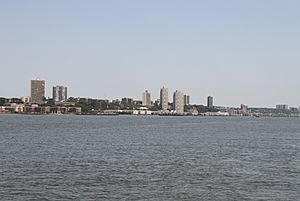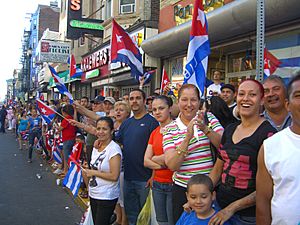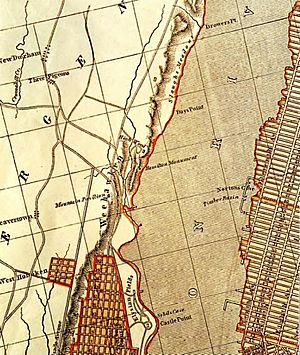North Hudson, New Jersey facts for kids

North Hudson is a special area in the northern part of Hudson County, New Jersey. It sits on the west side of the Hudson River, mostly on top of tall cliffs called the Hudson Palisades. This area includes five towns: Weehawken, Union City, West New York, Guttenberg, and North Bergen.
About 206,000 people live here, making these towns some of the most crowded in the United States. Many people living here were born in other countries, and a lot of the population is Hispanic. In most of these towns, many people speak a language other than English at home.
This area has been known for its history in the "American Embroidery Industry" and as a big center for silk. It's also sometimes called "Havana on the Hudson" because of its large Cuban population.
Contents
What's in a Name?
The name "North Hudson" is used for many important groups and services in the area.
Local Services and Groups
- Transportation: The North Hudson County Railway started around 1865, helping people get around.
- Health: North Hudson Hospital has been serving the community since about 1900.
- Parks: North Hudson Park opened around 1908, giving people green spaces to enjoy.
- Community: The Hoboken-North Hudson YMCA has been active since 1929.
- Emergency Services: The North Hudson Regional Fire and Rescue was created in 1998 when different town fire departments joined together.
- Water: The North Hudson Sewerage Authority helps manage water for Hoboken, Union City, Weehawken, and West New York.
Learning and Support
- Education: Hudson County Community College has a North Hudson Campus where students can take classes. Other schools like the North Hudson Islamic Educational Center and North Hudson Academy also use the name.
- Community Help: The North Hudson Community Action Corporation (started in 1965) and the North Hudson Regional Council of Mayors offer social services to people in the area.
A Modern Nickname
In the late 2000s, some people started calling North Hudson "NoHu." This shorter name was even used for a film festival that began in 2008.
North Hudson's Location and People
How Many People Live Here?
By 1947, about 175,000 people lived in North Hudson.
Today, according to numbers from July 2022, North Hudson has about 206,243 people. Here's how they are spread out:
- Guttenberg: 11,446 people
- North Bergen: 60,235 people
- Union City: 65,366 people
- Weehawken: 17,215 people
- West New York: 51,981 people
These towns are among the most crowded in the United States. Guttenberg is actually the most densely populated town in the whole country! It has about 57,116 people per square mile. Union City is the most crowded city in the U.S. for towns with over 50,000 people. Many people in North Hudson were born in other countries, and some towns have a majority Hispanic population.
What Does the Area Look Like?
North Hudson is mostly built on top of the Palisades, which are tall cliffs along the Hudson Waterfront. It's on the west side of the Hudson River, right across from Midtown Manhattan and the Upper West Side in New York City. To the south are Hoboken and Jersey City. To the east are the New Jersey Meadowlands.
Because it's so high up, North Hudson offers amazing views of the Manhattan skyline, the Meadowlands, and the Watchung Mountains. North Bergen has many hills, making it the city with the second most hills per square mile in the United States, after San Francisco.
You can also enjoy the Hudson River Waterfront Walkway, a path and park right along the river.
How Did the Towns Form?
North Hudson is north of Bergen, one of New Jersey's first settlements from 1660. Back then, this area was known as Bergen Woods. In 1840, Hudson County was created. North Bergen became a township in 1843.
As more people moved in during the late 1800s, new towns were formed from parts of North Bergen. These included Hoboken (1849), Guttenberg (1859), Weehawken (1859), Union Township and West Hoboken Township (1861), Union Hill (1864), and Secaucus (1900).
In the early 1900s, there was talk of all these towns joining together, but it didn't happen. However, West Hoboken and Union Hill did merge in 1925 to form Union City. Even though each town has its own government and schools, they often work together on services like fire-fighting, water, and emergency medical help.
North Hudson's Story
Early Days
The land that is now North Hudson was first home to the Munsee-speaking Lenape Native Americans. Henry Hudson explored this area for the Dutch in 1609-1610. The Dutch later claimed the land and called it New Netherland. They bought the land from the Hackensack tribe of the Lenape.
There were often fights between the Dutch settlers and Native Americans over land. In 1658, Peter Stuyvesant, a Dutch leader, bought the land again. The record of this purchase shows they paid with things like "80 fathoms of wampum" (shell beads), cloth, brass kettles, and even beer! In 1660, he ordered a fortified village to be built at Bergen to protect the area. This was the first permanent European settlement in New Jersey. In 1664, the British took control from the Dutch.
Waves of Newcomers
Like many places in the New York area, North Hudson has seen many groups of people move there over time.
- First came settlers from the Netherlands and British colonists.
- Then, German-speaking farmers and business owners arrived.
- Irish people came fleeing a famine.
- Later, refugees from World Wars moved in.
- In the 1960s and 70s, many Cuban immigrants came, followed by people from other South and Central American countries.
- More recently, people from all over, including young professionals, retirees, and families, have moved to the area.
Embroidery Capital
In the mid-1800s and early 1900s, many German Americans, along with people from Switzerland and Austria, settled here. They brought special machines and started the Schiffli lace making industry. This made the region famous as the "embroidery capital of the United States" and a major center for silk.
Many of the old factory buildings are still used for making clothes today, while others have been turned into art studios or homes. This German-American community also started America's Oberammergau, which is the longest-running passion play in the U.S., performed since 1915. The German-American Volksfest, a festival, has happened every year since 1874 at Schuetzen Park.

Havana on the Hudson
In the 1960s and 1970s, some residents moved to the suburbs. At the same time, many middle-class and professional Cubans, who were leaving the revolution in their home country, moved to North Hudson. They are often credited with helping the area grow and thrive, which led to the nickname "Havana on the Hudson". North Hudson has the second largest Cuban American population in the United States, after Miami. The Cuban Day Parade of New Jersey, which started in 2000, is a big yearly event in North Hudson. It begins in North Bergen and ends in Union City.
The area also used to have a large Jewish community. While that community became smaller, the Jewish population has been growing again since the year 2000.
Getting Around North Hudson
The narrow waterfront area at the bottom of the Palisades was once a very important part of the Port of New York and New Jersey's shipping industry. Train tracks were built both under and on the sides of the Palisades. The West Shore Railroad ran passenger trains and ferry services from Weehawken from 1884 to 1959.
Modern Transportation
- Ferries: NY Waterway brought back ferry service in the late 1980s. In 2006, they opened a new terminal on the Waterfront for boats that cross the Hudson River to Lower Manhattan and Midtown Manhattan.
- Light Rail: The Hudson-Bergen Light Rail opened in the early 2000s, connecting North Hudson to areas further south in Hudson County. It has stations at Tonnelle Avenue, Bergenline Avenue, Port Imperial, and Lincoln Harbor.
- Buses: New Jersey Transit buses are a popular way to travel. Bergenline Station is a major spot where you can switch between the light rail and many bus lines (like the 22, 84, 86, 89, 156, 159, and 181). Other major bus stops include Nungessers and Transfer Station, Hudson County. Buses also run along Boulevard East, Bergenline Avenue, Kennedy Boulevard, and 32nd Street to Manhattan and other towns.
- Mini-Buses: You'll also see many privately run mini-buses, sometimes called immi-vans or dollar buses. They travel along Bergenline Avenue to places like Journal Square, Downtown Jersey City, 42nd Street in Manhattan, and parts of Bergen County and Paterson.


